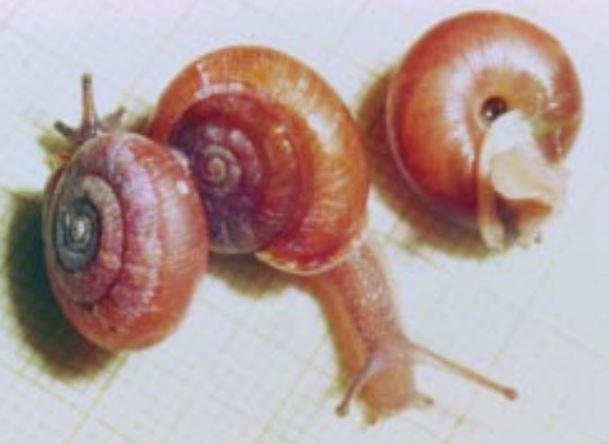Low-
Moderate
The Columbia Oregonian's overall abundance is low across its range. Population segments occur in fairly remote areas. Population trends have been declining; some populations have been extirpated. Snails in the Cryptomastix genus are of conservation concern because they have specialized habitat requirements. Snails do not readily disperse and populations are isolated. They are vulnerable to alteration of their habitat.
Description and Range
Physical description
The Columbia Oregonian is a medium-sized terrestrial snail in the genus Cryptomastix. The Cryptomastix species are medium to moderately large Pacific Northwest endemics.
The shell of the Columbia Oregonian measures 0.55 inch to 0.63 inches (14 to 16 mm) wide by 0.31 to 0.35 (8 to 9 mm) high. The spire is low, with 5 to 5-1/2 whorls, and the shell may show very faint ridges. The shell opening is rounded and white with a flattened lip. A whorl is the part of the shell that is one 360-degree section of the spiral; the spire consists of all whorls except the body whorl.
Ecology and life history
This species inhabits margins of low to mid-elevation seeps and spring-fed streams in an otherwise semi-arid landscape in associated talus in open, rocky prairies with few or no trees. It is typically found among moist talus, rocks and herbaceous vegetation.
Columbia Oregonians hatch from eggs and live for more than one year, but there is little information regarding reproduction, oviposition, eggs, development, or potential longevity of Cryptomastix species. The species is likely sedentary with limited active dispersal ability.
Cryptomastix species may be herbivorous, detritivorous, or fungivorous feeding on green plants during certain seasons and microorganisms associated with decaying leaf litter, such as algae, molds, yeasts and bacteria in others.
Geographic range
Populations of the Columbia Oregonian occur in fairly remote areas, with most locations isolated from one another by surrounding arid landscape. This species is known from both sides of the Columbia River in Oregon and Washington, from the Columbia River Gorge east and along the Snake River, through the Blue Mountains and Hells Canyon region to west-central Idaho, and is found north along the Yakima River as far as 3 miles north of Yakima. Washington counties include Klickitat, Yakima, Benton, Walla Walla, Columbia, Garfield, Whitman, Franklin and Asotin.
Climate vulnerability
Sensitivity to climate change
Low
There is limited information on the sensitivity of the Columbia Oregonian snail to climate change. This species is found in low-elevation seeps and streams of the Columbia River Gorge as well as mid-elevation upland habitats (782-1000 meters) in hemlock forests. In each of these locations, the snails find cover provided by herbaceous riparian vegetation in aquatic environments and large woody debris in forests. Loss of these refugia would likely alter the temperature and moisture regimes – low temperature and moderate to high humidity – upon which this species relies.
Exposure to climate change
Moderate-
High
- Increased temperatures
- Reduced soil moisture and/or drought
- Altered fire regimes
Conservation
Conservation Threats and Actions Needed
- Fish and wildlife habitat loss or degradation
- Threat: Loss of perennial flow due to diversions
- Action Needed: Taxonomic clarification for additional taxa; delineate occupied sites
- Threat: Habitat loss to development
- Action Needed: Delineate and protect sites
See the Climate vulnerability section for information about the threats posed by climate change to this species.
Resources
References
Applegarth, J. S. 1999. Management Recommendations for Cryptomastix hendersoni, the Columbia Oregonian (land snail) v.20, Section 2, in T. E. Burke, J.S. Applegarth, and T. R. Weasma. Management Recommendations for Survey and Manage Terrestrial Mollusks (v. 2). USFS and BLM.
Burke, T. E. 2013. Land Snails and Slugs of the Pacific Northwest. Oregon State University Press, Corvallis, OR. 344 pp.
Burke, T., J. Applegarth, T. Weasma, and N. Duncan. 1999. Management recommendations for Survey and Manage terrestrial mollusks, ver. 2.0. USDA Forest Service, USDI Bureau of Land Management. Available online at http://www.or.blm.gov/surveyandmanage/MR/TM23Species/m2000-003.htm
COSEWIC. 2013. COSEWIC assessment and status report on the Oregon Forestsnail Allogona townsendiana in Canada. Committee on the Status of Endangered Wildlife in Canada. Ottawa. xii + 87pp. (www.registrelep-sararegistry.gc.ca/default_e.cfm).
Duncan, N. 2009. Vespericola columbianus depressa. Species Fact Sheet. Interagency Special Status/Sensitive Species Program, Forest Service, Bureau of Land Management.
Edworthy, A., K. Steensma, H. Zandberg, and P. Lilley. 2012. Dispersal, home range size and habitat use of an endangered land snail, the Oregon Forestsnail (Allogona townsendiana). Canadian Journal of Zoology 90(7):875–884.
Frest, T. J., and E. J. Johannes. 1995. Interior Columbia Basin Mollusk Species of Special Concern. Final Report, Deixis Consultants, Seattle. Prepared for Interior Columbia Basin Ecosystem Management Project, Walla Walla, WA 362 pp.
Sato, C. 2021. Conservation assessment of the Columbia Oregonian (Cryptomastix hendersoni) Mollusca. Washington Department of Fish and Wildlife, Wildlife Diversity Division, Olympia, Washington. 3 pp.
Steensma, K. M. M., L. P. Lilley, and H. M. Zandberg. 2009. Life history and habitat requirements of the Oregon forestsnail, Allogona townsendiana (Mollusca, Gastropoda, Pulmonata, Polygyridae), in a British Columbia population. Invertebrate Biology 128:232–242.
USFWS. 2011. Endangered and Threatened Wildlife and Plants: 90-day finding on a petition to list 29 mollusk species as threatened or endangered with critical habitat: proposed rule. Federal Register 76 (No. 193, October 5, 2011): 61826-61853.
Other resources
- USDA Forest Service/USDI Bureau of Land Management - Conservation Assessment for Cryptomastix hendersoni, Columbia Oregonian (revised 2015) (PDF)
- USDI Bureau of Land Management, Oregon - Field Guide to Survey and Manage Terrestrial Mollusk Species from the Northwest Forest Plan (1999 (PDF))
- Oregon Dept. of Agriculture Guides - Slugs and Snails in Oregon - Joshua Vlach (PDF)
